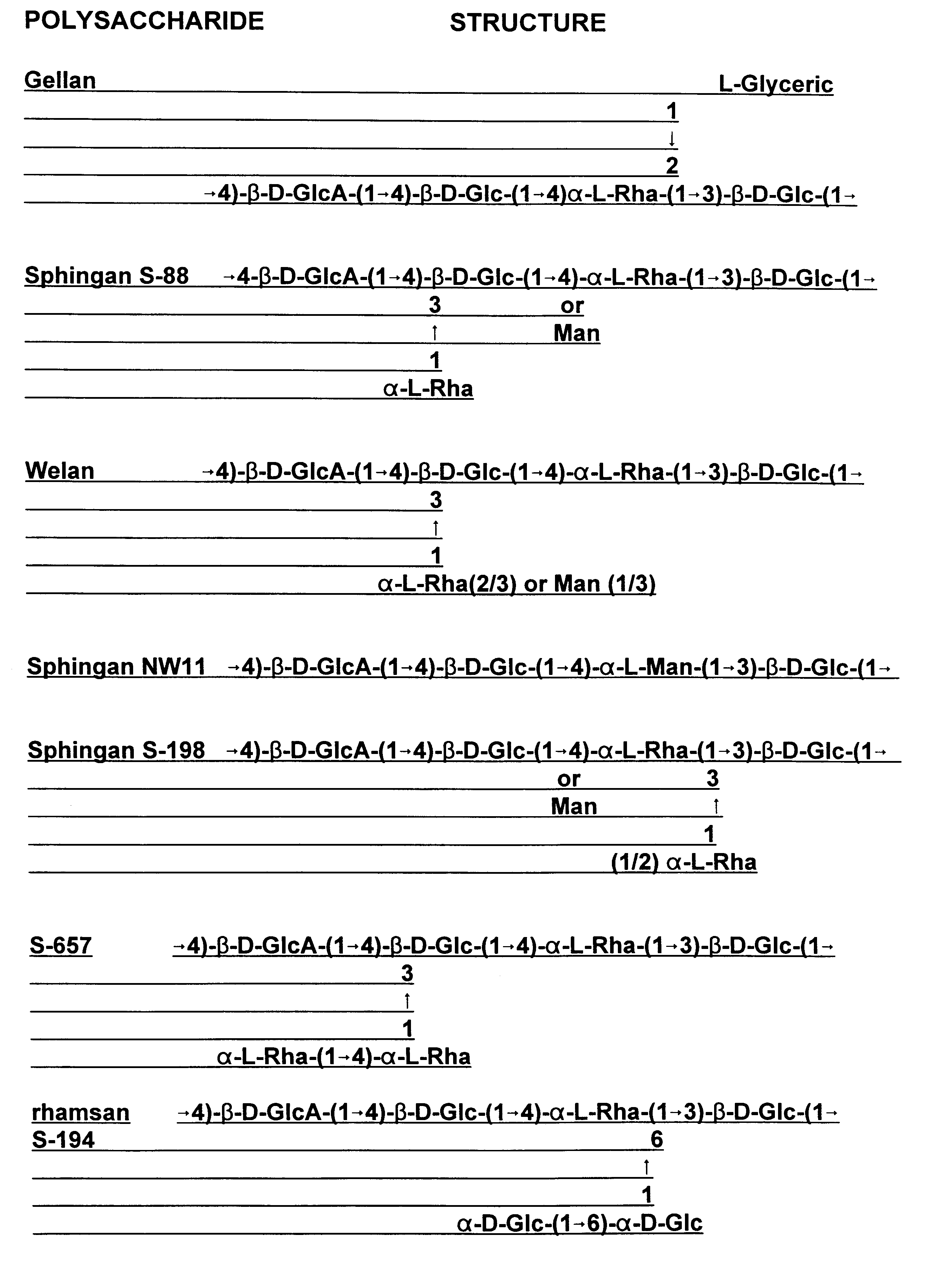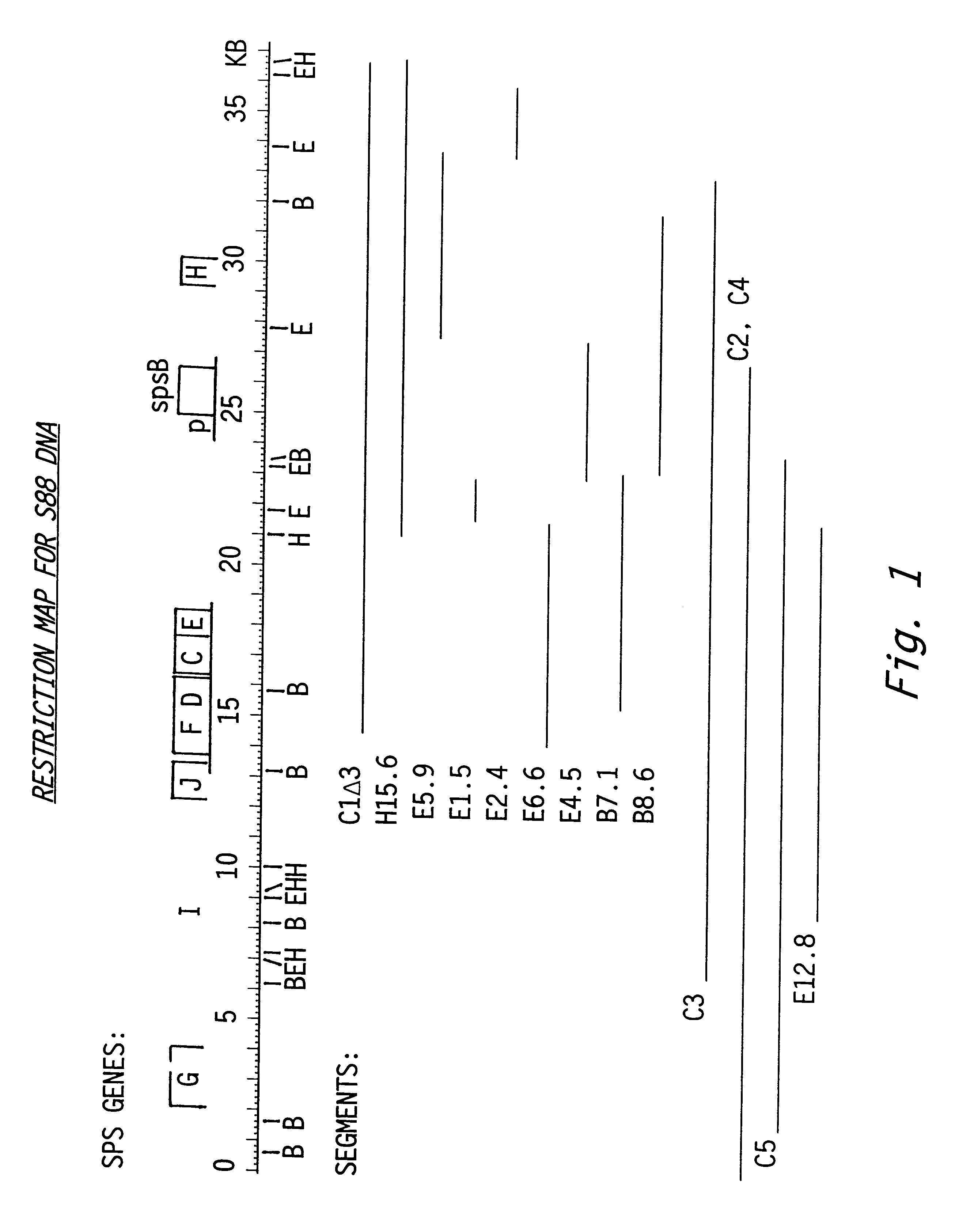DNA segments and methods for increasing polysaccharide production
a technology of dna segments and polysaccharides, applied in the field of dna segments and methods for increasing polysaccharide production, can solve the problems of not knowing what role the isoprenylphosphate carrier might play, and achieve the effect of enhancing the production of sphingan polysaccharid
- Summary
- Abstract
- Description
- Claims
- Application Information
AI Technical Summary
Benefits of technology
Problems solved by technology
Method used
Image
Examples
example 2
Isolation of Biosynthetic DNA Fragments for Sphingan S-88
Fragments of DNA cloned in plasmids were screened for the presence of genes essential for sphingan S-88 synthesis by observing restoration of sphingan synthesis in sphingan-negative mutants. Previously, we found that most of the spontaneous bacitracin-resistant mutants of Sphingomonas strain S88 capable of growing on YM plates containing bacitracin at 500-800 .mu.g / ml failed to produce sphingan polysaccharides (Pollock, et al., 1994, J. Bacteriol., 176, pp. 6229-6237). This formed the basis for a simple screening procedure for this special class of mutants.
Mutant S88m260 is a representative member of this Sps.sup.- Bac.sup.r group. The failure to make exopolysaccharides by S88m260 and the other Bac.sup.r Sps.sup.- mutants resulted in a colony appearance that was more flat, rough-surfaced and translucent compared to the wild type colonies, and the Bac.sup.r Sps.sup.- colonies were also surrounded by a narrow light-refracting ha...
example 3
DNA Sequence of the spsB Gene and Deduced Amino Acid Sequence of the SpsB Protein
The double-stranded nucleotide sequence for 1950 bp of the spsB region was obtained from a fragment of 3300 bp subcloned from plasmid pSEB24-S88E4.5::Tn#72. The sequence of the coding strand is given in FIG. 4. There was one long open reading frame (ORF) which we named spsB. The coding region began with ATG at nucleotide 361 (base A numbering from the left edge of the S88 DNA shown in FIG. 1) and continued until the TGA stop codon at 1771. This ORF coded for 470 amino acids and was preceded by a putative ribosome binding site. The deduced amino acid sequence using standard single-letter abbreviations is given in FIG. 5. Each letter in the figure corresponds to an amino acid using standard single-letter abbreviations.
example 4
DNA--DNA Hybridization of the Cloned S88 Segment and the Chromosomal DNA of either S88 or S60
To show that the cloned DNA in plasmid pRK311-S88c1.DELTA.3 derived from contiguous sequences of S88 DNA we labeled plasmid S88c1.DELTA.3 DNA and hybridized it to separated restriction fragments of DNA from Sphingomonas strains S88, mutant S88m260, and S60, the wild type producer of gellan. The presence of hybridization to EcoRI fragments of about 1.5, 2.4, 4.5, 5.9, and 12 kbp is consistent with continuity for the cloned DNA in both the wild type and mutant DNA. The leftmost 6.6 kbp fragment shown for S88c1.DELTA.3 is actually 12.3 kbp when the overlapping clones S88c2, S88c3, and S88c4 are digested with EcoRI, because one of the EcoRI sites is from the multiple cloning site of the vector. The hybridization between S88 DNA and S60 DNA, which produces gellan, indicated that similar gene sequences are present but that the gene organization may be different. Because of the structural similarit...
PUM
| Property | Measurement | Unit |
|---|---|---|
| temperature | aaaaa | aaaaa |
| temperature | aaaaa | aaaaa |
| temperature | aaaaa | aaaaa |
Abstract
Description
Claims
Application Information
 Login to View More
Login to View More - R&D
- Intellectual Property
- Life Sciences
- Materials
- Tech Scout
- Unparalleled Data Quality
- Higher Quality Content
- 60% Fewer Hallucinations
Browse by: Latest US Patents, China's latest patents, Technical Efficacy Thesaurus, Application Domain, Technology Topic, Popular Technical Reports.
© 2025 PatSnap. All rights reserved.Legal|Privacy policy|Modern Slavery Act Transparency Statement|Sitemap|About US| Contact US: help@patsnap.com



